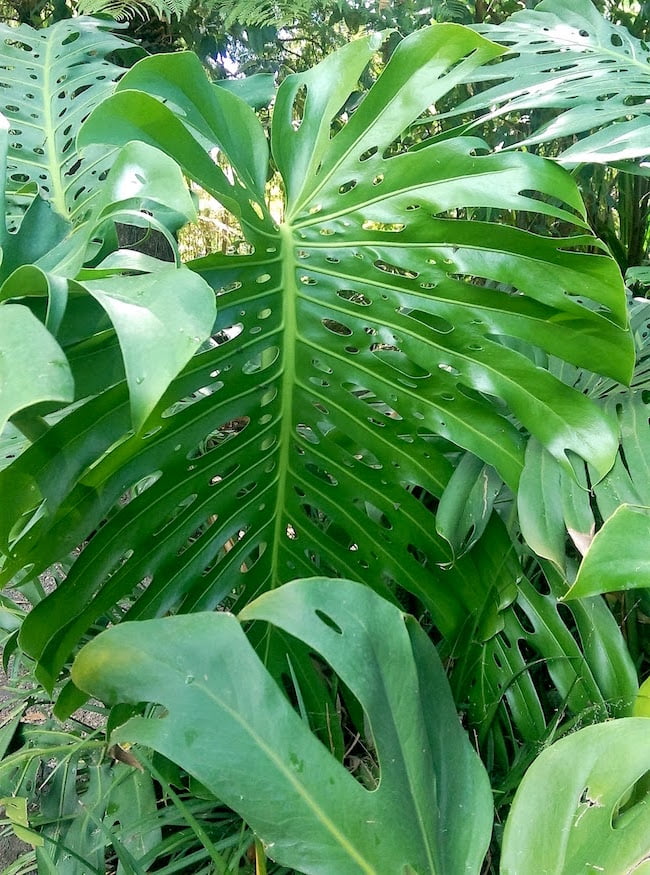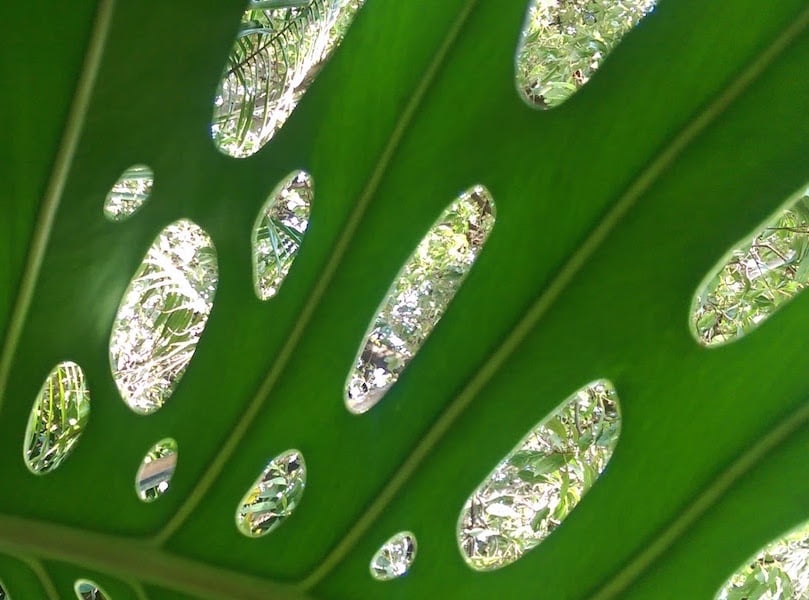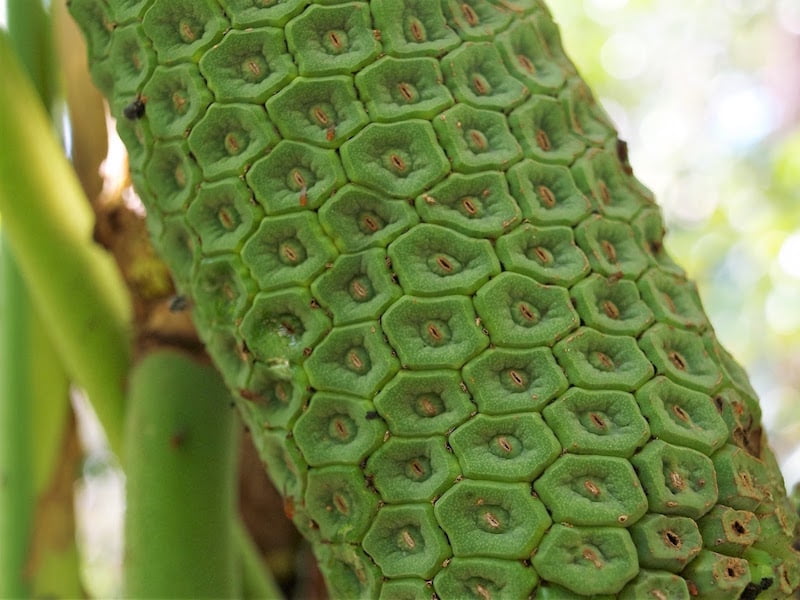The leaf of the Swiss Cheese Plant, Monstera deliciosa, is nothing like a cheese of any kind when young. As it ages, perforations reach deep into the leaf and holes appear towards its centre. It becomes fern-like (pinnate), but with holes…

Monstera deliciosa juvenile foliage
While lots of leaves have notches and crannies at their edges, it’s rather rare to find completely encircled holes. Interestingly, and pointing to some genetic trigger, most of the 40 species of Monstera have them, to varying degrees.

Mature Monstera deliciosa foliage showing pinnate leaves and leaf holes
The question of how and why the holes form has taxed some of the greatest botanical minds, although mostly it has be said without much evidence. (Mostly too, at least in the nineteenth century, it taxed botanists with a venerable prénom…)
When the Swiss Cheese Plant made it to Europe from its home in the tropical rain forests of southern Mexico to Central America, it was quite a sensation. Fittingly, it was the Swiss botanist Augustin de Candolle who in 1827 first commented on their possible origin. A sign of weakness in the leaf, he said, a debilitation.

Close-up of leaf holes in Monstera deliciosa
French botanist Augustin Saint-Hilaire disagreed entirely. It must be excessive vigour he exclaimed in 1840, In 1854, fellow countryman, Auguste Trécul, actually examined the leaves as they grew and found that the holes were caused by cells dying in the effected areas and that the leaf continuing on beyond them. This didn’t solve the ‘why’ but helped with the ‘how’.
In 1969, two botanists from Royal Botanic Gardens Kew, Robert (Melville) and ‘F.A.’ (Wrigley), confirmed that the holes were a ‘necrosis’ (a dying of cells). The compared them to colour blotches on the leaves of the Zebra Plant, Calathea, finding the patterns quite similar and more or less explained by the Diffusion Reaction Theory proposed by the great, and scandalously treated, mathematician Alan Turing. The theory appears describes the pattern caused by the interaction of growth promoting substances interacting with some kind of growth inhibitor. Again it’s more to the how than the why.

Close-up of leaf holes in Monstera deliciosa
Over the years a few whys have been suggested: for example, allowing water to drip to the ground and get closer to the roots, keeping the leaf cool, camouflaging the leaf to protect it from from animal grazing, and in recent years (2013) a rather complicated (to me) hypothesis where growth of the leaf is kept more consistent by having holes in it resulting in an advantage for a plant growing in a largely shaded habitat with dappled light.
Personally I’m attracted to the idea that holes might allow leaves to better survive hurricanes or similar dramatic wind events. I’m familiar with the punching of holes in large signs made of cloth for the same reason, and can see this being an adaptive pressure (i.e. a thing that allows the plant to live and reproduce longer).
Kit Wignall, touring with me to Spain in May, suggested it might be a way to reduce the weight of the leaf while extending it as far as possible. Which does make good sense. So perhaps I favour the combination of weight reduction, light penetration to lower leaves and a bit of hurricane protection thrown in for good luck.
For now though, it seems no-one really knows. And that’s just one of the intriguing characteristics of the Swiss Cheese Plant. In case you are intending to eat the fruit, don’t. At least not without some planning.

Developing fruit on Monstera deliciosa, Swiss cheese plant
The unripe fruit, as pictured here, contains irritating chemicals such as oxalic acid. After a year or so, the hexagonal scales will dry out to reveal the white (edible) pulp of the fruit below. Alternatively, I gather, you can pick the fruit when the base starts to wrinkle and wrap it in a bag for a few days until the scales have separated.
The University of Connecticut, my source of the fruit information, also lets us into an intriguing fact about its seedlings. When they germinate the first shoot seeks out the darkest place it can. Not, just away from bright light but to where things are at their blackest. Once it finds suitable substrate – for example the base of a tree – it then sends a shoot light-ward, towards the canopy. In this case the why is pretty clear but the how I’ll leave for another day.
[Notes: All the pictures are from The Ian Potter Foundation Children’s Garden at Melbourne Gardens, Royal Botanic Gardens Victoria, except the picture of the fruit, which was taken in my backyard at Sydney a few years back. And thanks to Peter Symes for suggesting this fascinating but still unresolved topic!]
